-
Paper Information
- Next Paper
- Previous Paper
- Paper Submission
-
Journal Information
- About This Journal
- Editorial Board
- Current Issue
- Archive
- Author Guidelines
- Contact Us
Education
p-ISSN: 2162-9463 e-ISSN: 2162-8467
2012; 2(5): 130-135
doi: 10.5923/j.edu.20120205.04
A Development of a Computer-Assisted Software (AJaW) That Encourages Jawi Writing for Children
Norizan Mat Diah , Marina Ismail , Putri Mazliana Abdul Hamid , Suzana Ahmad
Computer Science Department Faculty of Computing and Mathematical Sciences, Universiti Teknologi MARA, Malaysia
Correspondence to: Norizan Mat Diah , Computer Science Department Faculty of Computing and Mathematical Sciences, Universiti Teknologi MARA, Malaysia.
| Email: |  |
Copyright © 2012 Scientific & Academic Publishing. All Rights Reserved.
JAWI script is based from the writings of the Al-Quran, which is Holy Book for the Muslim. JAWI also is the oldest Malaysian written artifact. Though JAWI holds very important identity of Malaysians, it was slowly overshadowed by Roman script. Due to this matter, younger generation need to be well educated with JAWI script in order to preserved it from extinction. Researchers realized that one of the difficulties in teaching JAWI script among children is due to the lacking of fine motor skills. This article will discuss the software development issues for children between the ages of 4 to 6 years old in learning to write the JAWI characters by focusing on the motor skills development in the writing process. Software was developed by researchers using Hannafin and Peck’s Instructional Model. This software was created as a learning tool for children between the ages of 4 to 6 years old. The design of the software focuses on the hand movements in the writing process. Learning process includes the demonstration on proper pencil-holding techniques, the pre-writing activity, exercise and evaluation. This software has been tested for its multimedia appearance, learnability and capability to scaffold learners’ writing activities using graphic tablet. Result showed that learners enjoy using the application and able to develop their fine motor skills. Researchers believe that software which enforce on fine motor skills would improve children's writing skills especially on JAWI scripts. Researchers also hope that, JAWI scripts will be preserved and accepted by many.
Keywords: Jawi, Writing, Children
Article Outline
1. Introduction
- Handwriting is generally slow and difficult for young children and they usually need several years of formal instruction before they are able to master this skill[2]. Formal handwriting instruction may begin as early as the kindergarten years [3]. Research showed that children spend between 30% to 60% of their school classroom time doing writing activities using paper and pencil[4]. The development of the writing ability is not only important in building a child's self-esteem, but is considered an important pre- requisite for success in school[5]. This is due to the direct effect handwriting has on academic performance[6]. Children who struggle with their handwriting may avoid writing and may decide not to write[7]. This will hinder the learning process. Such problems also occur in learning Jawi[8]. Nik Yaacob[9] has emphasized that learning to write Jawi must be taught at an early age. A proper and appropriate technique must be adopted to make learning to write Jawi as an interesting activity. Jawi is currently taught in schools. However, the methods used to teach Jawi writing is not attractive[9,10]. Current teaching methods are still stuck at the use of chalk and board approach and cards. Hence, it is important to have a suitable learning tool such as having an educational multimedia courseware in order to develop interest towards learning to write Jawi characters. The tool must be equipped with appropriate interactivity tool and proper interface design suitable for the learners of the designated age group.Devaraju et. al.[11] believes that multimedia application can motivate learners if the user is allowed to control the multimedia elements that are presented. When control is provided, it will create an interactive learning environment. Kamaruddin[12] added that for an interactive learning environment, the designer should allow the user to have a certain control on the learning process. Kamaruddin[12] also added that simply knowing the interface design concepts is not sufficient for the creation of an effective learning courseware. A good learning to write approach must be presented in assisting learners to learn to write. This paper will focus on the software development process of creating a multimedia tool to assist learners in learning to write Jawi characters.
2. Background of the Research
- Jawi is the writing script for the Malay language since the 15th century and was derived from the Arabic alphabets. The characters are based on Arabic scripts with some additional characters in order to suit the Malay sound system. Similar to learning other languages and its characters, learning Jawi involves the process of knowing Jawi characters, its’ shape, writing, connecting the characters and reading the Jawi text.Nowadays, Jawi writing is gradually forgotten either in writing or reading. This is because of the growing focus on the roman characters in daily communication[13]. Less distribution of Jawi materials has also been a contributing factor to the lack of awareness on Jawi[14]. This resulted in low interest in Jawi among the younger generation in Malaysia. Thus, the younger generation, especially the Malays, are alienated from Jawi.Jawi skills among children are important as the skills will help them in their Islamic education. The skill is required when reading the Qur'an, learning the Arabic language and all other Islamic religious subjects. For students who are unable to master the Jawi reading and writing skills, they will be left behind in the Islamic subjects as Jawi is commonly used by teachers as a tool or medium to teach these subjects[15]. Research by[16] found that 95% of students have negative attitudes towards Jawi because they found it to be very difficult, they felt that it is not important and that subject is not assessed in the national level examinations. This leads to the decrease in motivation and enthusiasm towards the Islamic Education subjects[17,18]. A study by[14] found that the main contributing factor to weakness in mastering Jawi among children is more on writing than reading. Steps are needed to inculcate the love for Jawi among children. This may happen when children are introduced to Jawi writing and reading in an attractive manner. Current education system does include Jawi. However, due to time constraints, insufficient time is being allocated and concentrated in learning how to write Jawi[14]. This is proven by Penguasaan[8] in a survey on Jawi writing proficiency among school children. The survey showed that some children are unable to master Jawi writing even at the age of 9. Most of them are having problems writing Jawi characters that are considered difficult such as ح, ع, and ف compared to simple characters like ا, ب, ل and و.Even though Jawi has existed a long time ago in the Malaysian history, there are still however, people who cannot read or write Jawi. Measures have been taken by several parties to preserve Jawi writings. Examples of the initiatives are using Jawi writing alternatively or simultaneously with roman letters for major road names, the publishing of Jawi newspaper by Utusan Malaysia Publishing, a local newspaper, and the use of Jawi in primary and secondary school textbooks for Islamic Education[19].
3. Software Development
- Development of this Assisted Jawi-Writing(AJaW) software is not similar to the development of any other courseware. AJaW requires extra consideration on factors regarding the writing process, hand movement and the motor skills development in order to produce a usable application. For this study, the prototype has been developed based on Hannafin and Peck’s[1] Instructional Model. Hannafin and Peck’s model was chosen as it emphasizes on evaluation and revision which is crucial in the development of a motor-skill-based application. The model consists of three phases, the needs assessment phase, followed by the design phase and finally, development and implementation phase. Each of these phases was evaluated and revised regularly to produce an effective outcome.
3.1. Needs Assessment Phase
- In this phase, analysis was done to identify the need to develop the courseware. It involves the process of identifying the problem statement, the goal and objective of the courseware to be developed. Also identified is the knowledge and the skills of the learner who will be using this application. The analysis is carried out by reviewing journals and articles about the development of fine motor skill in writing for children, and interviews with teachers about children’s learning to write process. Through the analysis, the indication of the suitable technique to hold a pen and writing is discovered. This is important in order to produce legibility handwriting and a correct way of holding the writing tools. The needs to Jawi writing and the use of interactive instructional application are also being considered. All information gathered were used to develop goals and objective of developing the courseware. The software and hardware requirement are also determined in this phase. Each of the steps done in this phase were evaluated and revise by conforming with the literature review and expert. The flow of needs assessment phase is shown in Figure 1 below.
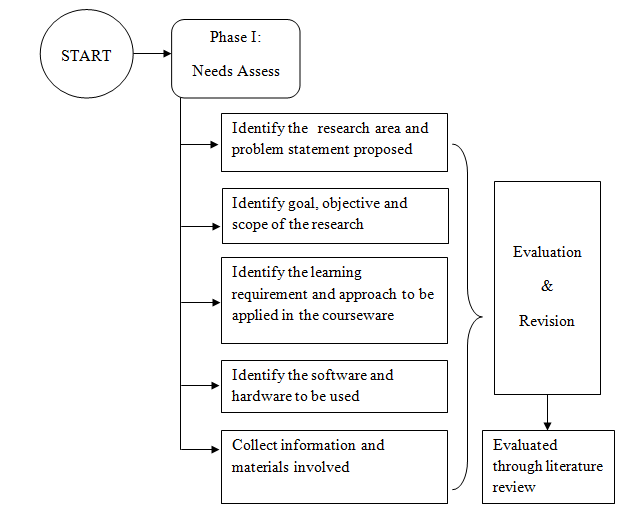 | Figure 1. The flow of Needs Assess Phase |
3.2. Design Phase
- The design phase involves the development of the conceptual model for the courseware which involves the learning theory and the medium to be used in the application; the teaching and learning approach to be implemented and the components involve in this the application. This model is again evaluated and revised based on the literature review in order to detect any inconsistency that may be involved. The flowchart and story board are also created during this phase. The flowchart will show the flow of the application while the story board exemplify the sequence of learning and the interface layout that will be provided to the user. The layout also includes the multimedia elements that are design to suit the learning process. The consideration is made based on the conceptual model that has been created to make sure the purpose of teaching and learning is aligned. The flow of design phase is shown in Figure 2 below.
 | Figure 2. The flow of Design Phase |
3.2.1. Conceptual Model
- The framework is shown in Figure 3 below. The framework lists the following components as the important components to be included in the development of AJaW. They are:• Teaching and learning approachMotor skill approach is the crucial component adopted for AJaW as it focuses on the movement of the hand during writing.• Learning taxonomyTwo major learning approaches were adopted for the application. They are the cognitive learning theory for the recognition of motor movement and psychomotor for the acquisition of motor movement.• Teaching and learning mediumThe teaching and learning medium that is used are the multimedia elements such as text, graphics, sound and animation with the focus on the interactivity.• Prototype developmentThe framework design involves the development of the application modules. The design is based on the important components that are considered a must in learning to write process. Based on the literature review, five modules are designed with pre-writing activity as the main module. The modules are the pen holding or gripping demonstration, pre-writing activities, demonstration of writing Jawi character, writing Jawi character exercise and the Jawi writing test. The pre-writing activity consists of scribbling (drawing continuous lines of wavy or zig zag pattern), coloring (shading using different color within a boundary), channeling (drawing a line between two boundaries) and tracing (joining lines between adjacent points). All of these activities will be explained further in the following section.
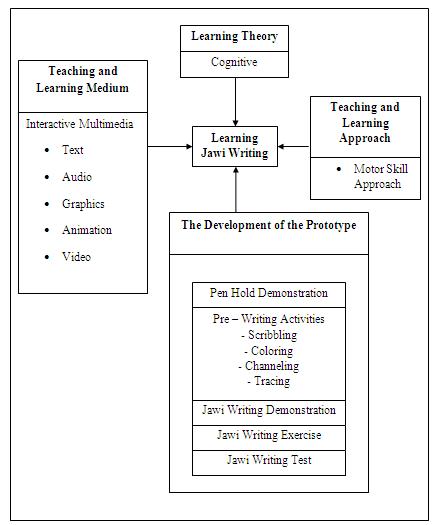 | Figure 3. Framework for Learning To Write Jawi |
3.2.2. Flowchart
 | Figure 4. Flowchart for Learning Jawi Writing Prototype |
3.2.3. Storyboard
- This storyboard shows the look and feel of the application that will be developed. Some of the story board can be seen in figure 5, 6, 7 and 8 below:
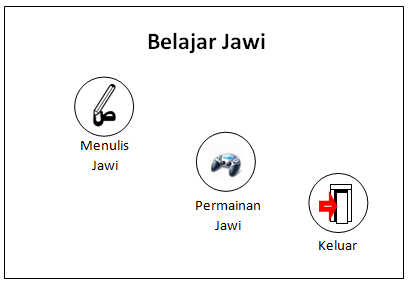 | Figure 5. The storyboard of the main menu |
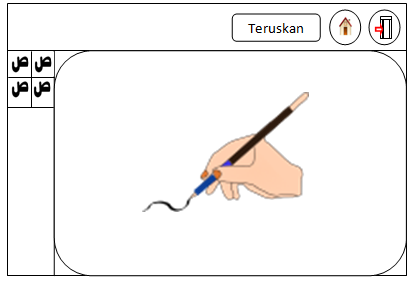 | Figure 6. The storyboard of the Pen Demonstration |
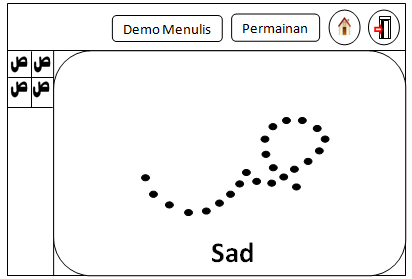 | Figure 7. The storyboard of the Writing Exercise |
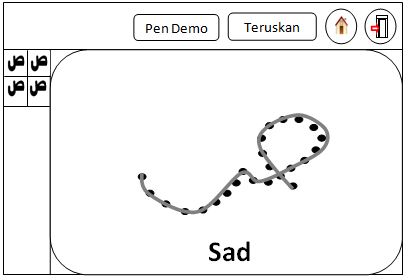 | Figure 8. The storyboard of the Writing Demonstration |
3.3. Development and Implementation Phase
- In the development phase, all that have been planned and created during the design phase will be used to develop the application. The multimedia authoring tools will be used to integrate the entire multimedia element that has been created and edited. To make sure the application development is done correctly, the development phase will regularly be viewed back to the conceptual model, flowchart and story board that has been designed in the design phase.In the pen-demonstration module, which is at the beginning of the application, the pen-holding technique is displayed(Figure 9). This activity nurtures the motor skills of the learner. Motor skill is further developed through writing exercises using the graphic tablet. This skill is observed through testing that is conducted with target users. The cognitive element in this prototype is observed when the learner can recognize the Jawi character and the motor movement.
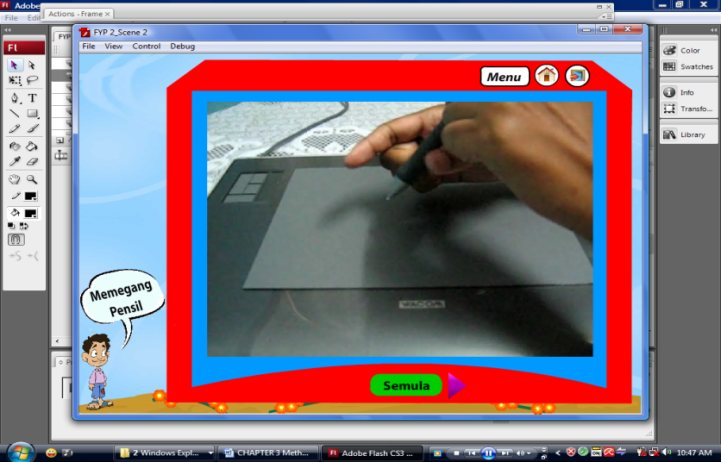 | Figure 9. Pen demonstration module Screen |
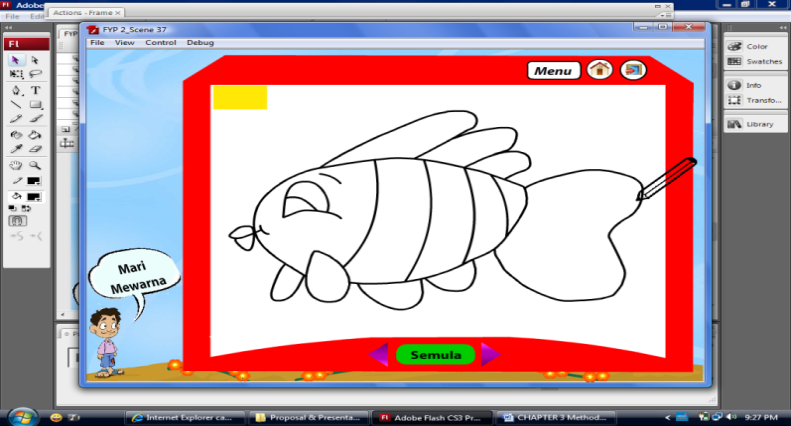 | Figure 10. Example of Coloring Activities Screen |
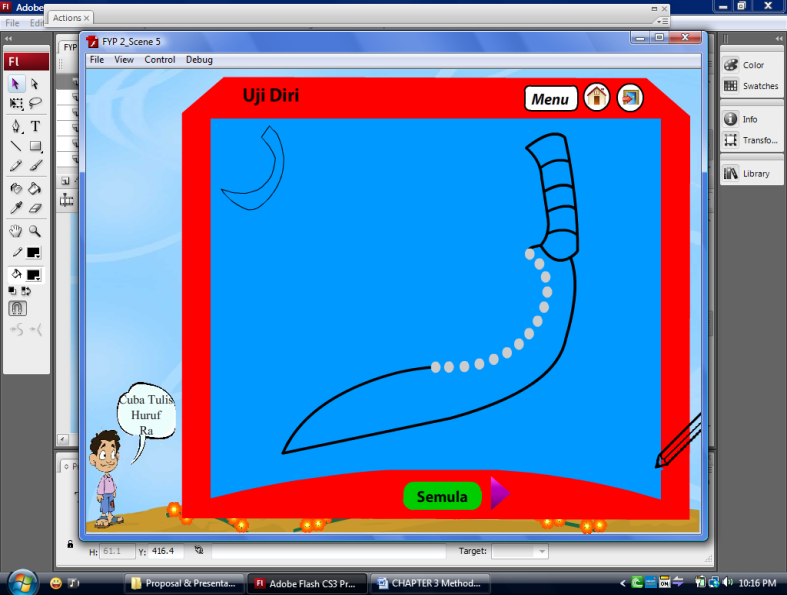 | Figure 11. Jawi Practice Writing |
 | Figure 12. The flow of Develop and Implement Phase |
4. Results and Findings
- The application has been tested on the target audience who are randomly picked. Through the test, several criteria have been observed. The criteria are as follows:The interest shown by the participants towards the prototype.The content attractiveness towards the participants.The participants’ level of comprehension of the content.The motivation of the participants to complete the activities.The observation shows that all participants were interested in exploring all activities within the software, especially the use of graphic tablet as an input device. The participants were initially not familiar with the haptic technology as they usually use mouse and keyboard to interact with the computer. However, they were all comfortable with the device after several trials prior to the actual evaluation procedure. The participants were also fascinated with the multimedia content, namely the graphics, animation, text and audio that were included. They found that these elements were attractive, interactive and user friendly. All the participants had high level of comprehension when doing activities such as colouring, scribbling and tracing. However, they had difficulties when executing the channeling activities especially involving the circling activities. Levels of satisfaction varied among activities. Some participants had high motivation for scribbling, tracing and coloring activities while the motivation decreased during the channeling activity which resulted in the participants moving to another activity without completing the channeling activity.
5. Conclusions
- The software allows young children to learn how to write Jawi at an early age. The research was carried out to attract children to learn to write Jawi and increase their interest and understanding in the subject. The implementation of motor skills which involves the movement of the finger and hand in this research has helped the children to practice and improve their writing skills. The proper way of holding a pen and write Jawi letters may help children to perform more complex activities and letter- formation in the future.
ACKNOWLEDGMENTS
- First and foremost, we would like to thank to our friends, Mr Ridzuan Mohamad, Mrs Nor Ashikin Mohamad Kamal, Mrs Norasiah Mohamad and Mrs Norzehan Sakamat for the valuable guidance and advice. We would also like to thank the authority of Universiti Teknologi Mara(UiTM) for providing us with a financial support and facilities to complete this project.
 Abstract
Abstract Reference
Reference Full-Text PDF
Full-Text PDF Full-Text HTML
Full-Text HTML